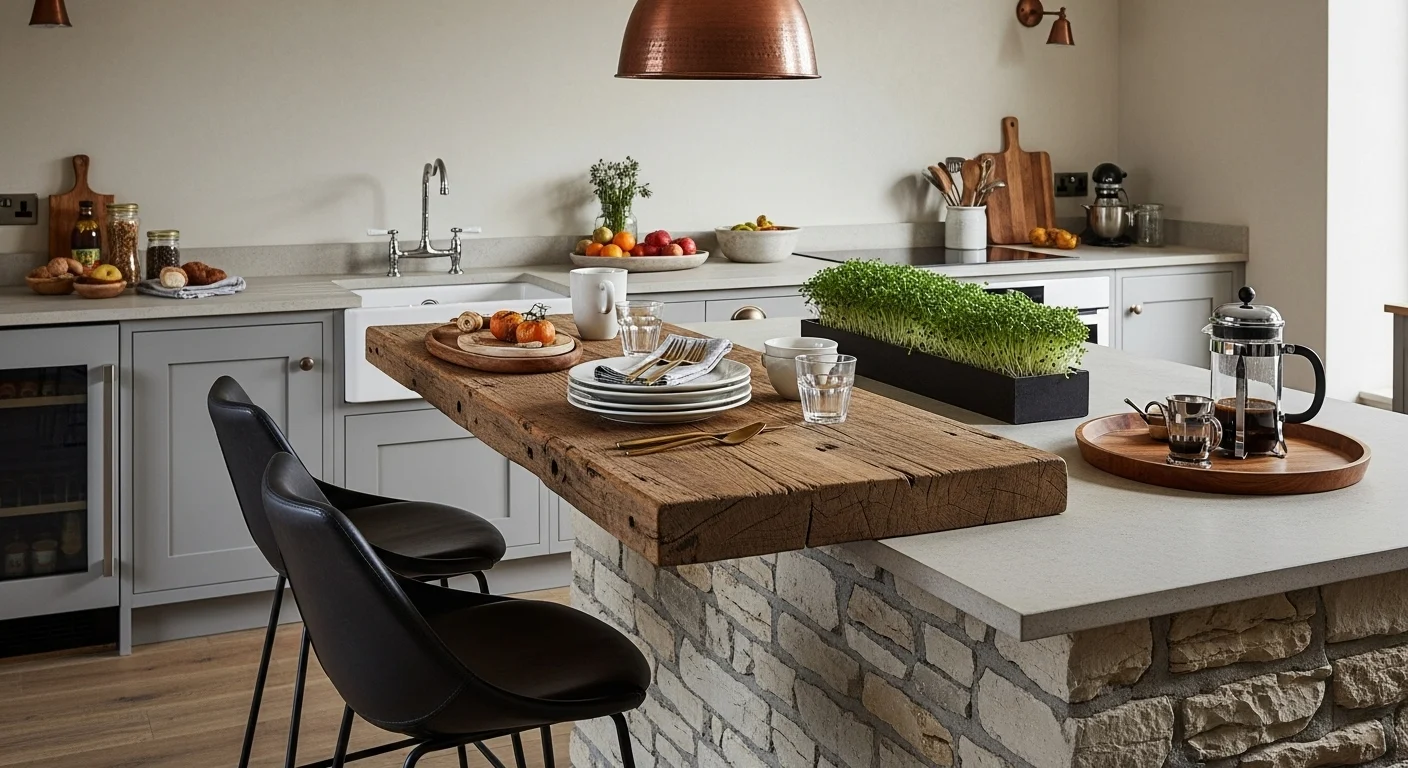So you love that rustic kitchen vibe but you’re worried about creating something that looks more like a theme restaurant than a sophisticated space where you’d actually want to cook every day. You’ve probably seen those “rustic” kitchens that are just wood everything with some mason jars thrown around, or the ones that went so overboard with the farmhouse aesthetic they forgot about function entirely.
Here’s what most people get wrong about rustic kitchen design: they think it’s about making everything look old and weathered. But real rustic style is about celebrating natural materials, honest craftsmanship, and creating spaces that feel grounded and authentic while still being genuinely luxurious and functional.
Whether you’re renovating from scratch or trying to add rustic elements to your current kitchen, these approaches will help you create something that feels both connected to traditional craftsmanship and completely current in its sophistication.
Understanding What Makes Rustic Actually Work
Before diving into the specific elements, let’s clear up what separates sophisticated rustic kitchens from ones that feel like themed attractions.
Quality Materials Over Artificial Aging – Real rustic style uses genuinely beautiful natural materials rather than trying to make new things look old and beat up.
Balance Prevents Theme-Park Effect – The best rustic kitchens mix rustic elements with refined touches to create sophistication rather than overwhelming country vibes.
Function Must Come First – Rustic doesn’t mean sacrificing modern convenience. The goal is creating spaces that work beautifully for contemporary cooking while celebrating traditional materials.
15 Ways to Create Authentic Rustic Kitchen Style
1. Anchor Your Space With a Live-Edge Island and Waterfall Marble
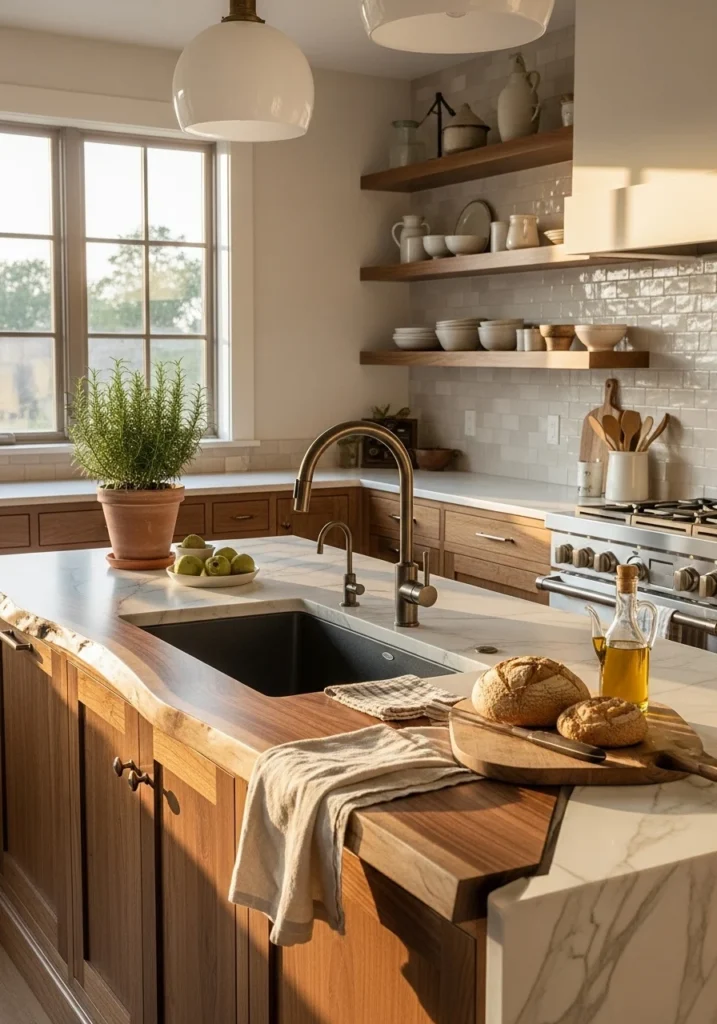
Create a stunning centerpiece using a live-edge walnut island paired with a honed white marble waterfall countertop. Add a matte black undermount sink with matte brass gooseneck faucet, while inset cabinetry in warm oak provides storage.
Include a backsplash of hand-cut cream subway tile with floating wooden shelves displaying curated ceramics. Stage with artisan bread on wood boards, olive oil cruets, and linen runners to show how the space works for real cooking and entertaining.
2. Add Architectural Drama With Reclaimed Beams and Steel Hoods
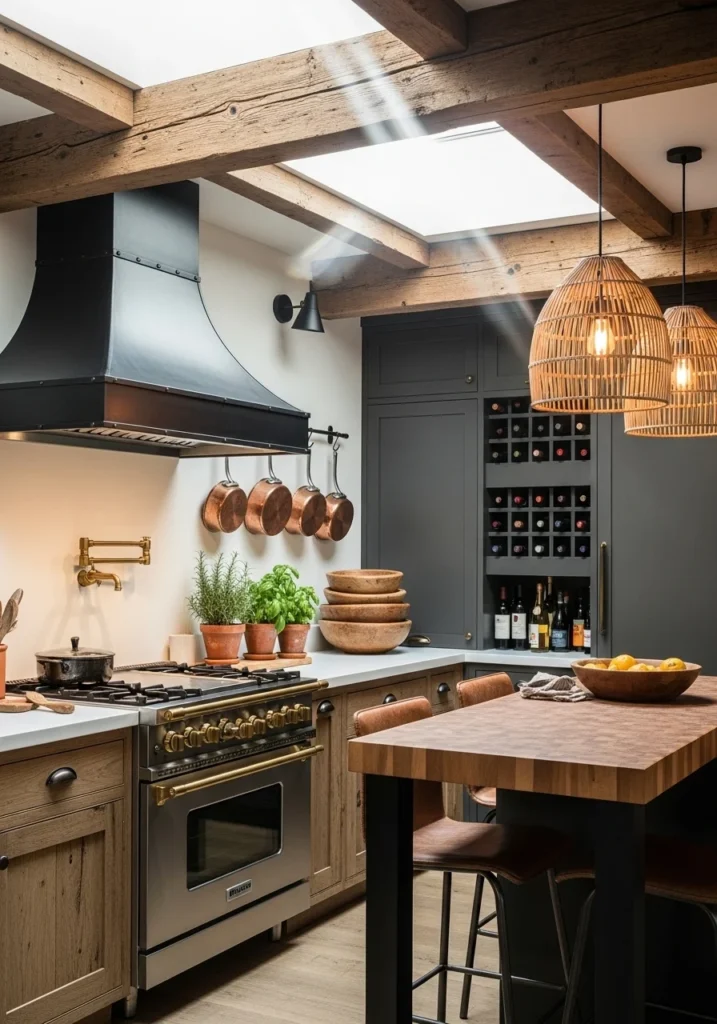
Install reclaimed timber beams overhead paired with a custom black steel range hood as your focal point. Use a professional brass range with two-tone cabinetry—distressed oak bases and matte charcoal uppers—plus butcher-block prep counters for authentic work surfaces.
Include woven pendant lights and leather counter stools while building in wine storage niches. Display copper pans, fresh herbs in terracotta pots, and stacked wooden bowls to show the kitchen’s connection to traditional cooking methods.
3. Create a Cooking Hearth With Stone and Wood-Fired Elements
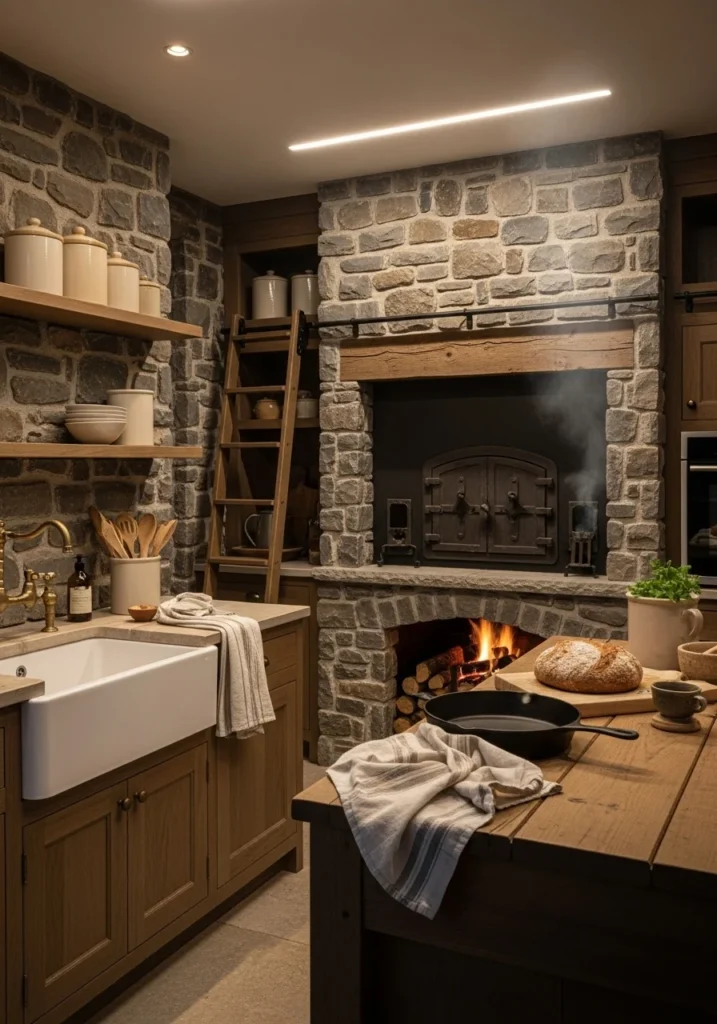
Build a stone hearth housing a wood-fired oven with iron doors as your kitchen’s heart. Use reclaimed stone walls, deep farmhouse sinks with aged brass fittings, and low islands with thick plank tops that feel substantial and permanent.
Add open shelving with antique ceramic crocks and access ladders for upper shelves. Stage with cast-iron skillets and freshly baked bread to emphasize the connection between rustic materials and genuine cooking traditions.
4. Layer Interest With Two-Tone Distressed Cabinetry
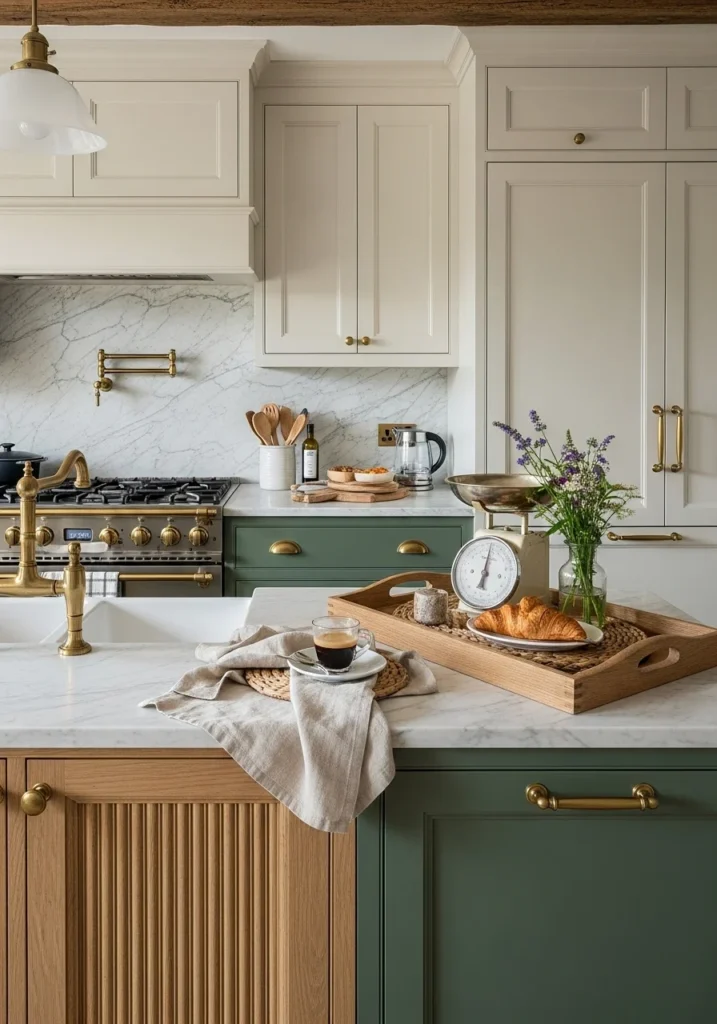
Use two-tone distressed cabinetry with mossy green lower cabinets and cream uppers for sophisticated color layering. Feature book-matched marble backsplashes behind brass ranges, white apron sinks, and fluted oak island panels.
Add brass cup pulls and integrate paneled appliances to maintain clean lines. Style with vintage scales, woven placemats, and wildflower bouquets to show how rustic elements can feel collected rather than newly purchased.
5. Build Community With Curved Banquette Dining Areas
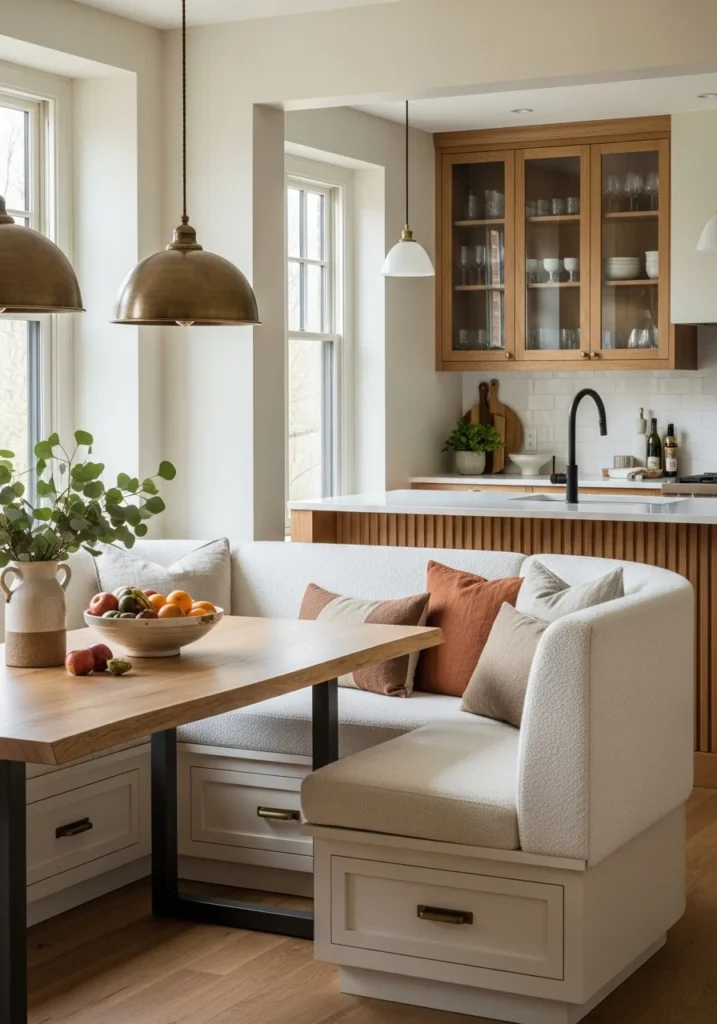
Include curved built-in banquettes upholstered in boucle paired with live-edge oak dining tables. Hang antique brass pendants low over the table with linen cushions and hidden storage drawers beneath the seating.
Connect to the kitchen through fluted timber islands, matte black faucets, and glass-front cabinets. Stage with handblown glassware and ceramic fruit bowls to emphasize the social aspects of rustic kitchen design.
6. Embrace Minimal Rustic Through Plaster and Hidden Appliances
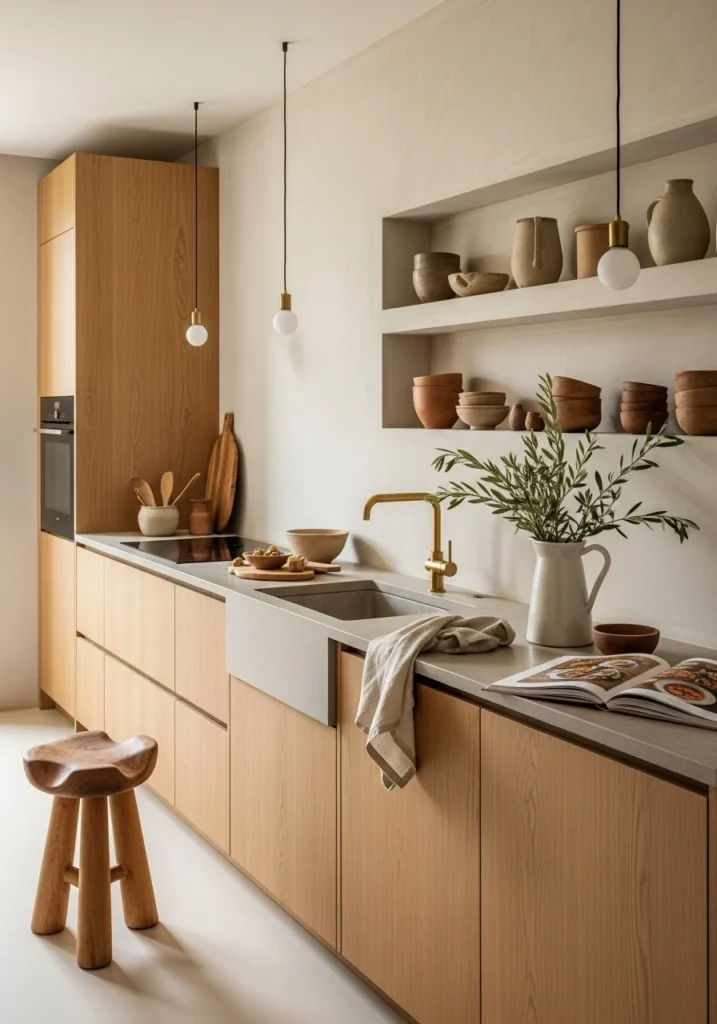
Create minimal rustic style using warm lime-wash plaster walls, seamless handleless oak cabinetry, and completely integrated appliances. Use thin honed stone countertops with recessed shelving for curated pottery displays.
Add narrow brass taps above concrete trough sinks with simple pendant lights and sculptural wooden stools. Style with single ceramic pitchers, folded linen towels, and open cookbooks to show refined simplicity.
7. Add Warmth Through Copper and Blackened Steel Contrasts
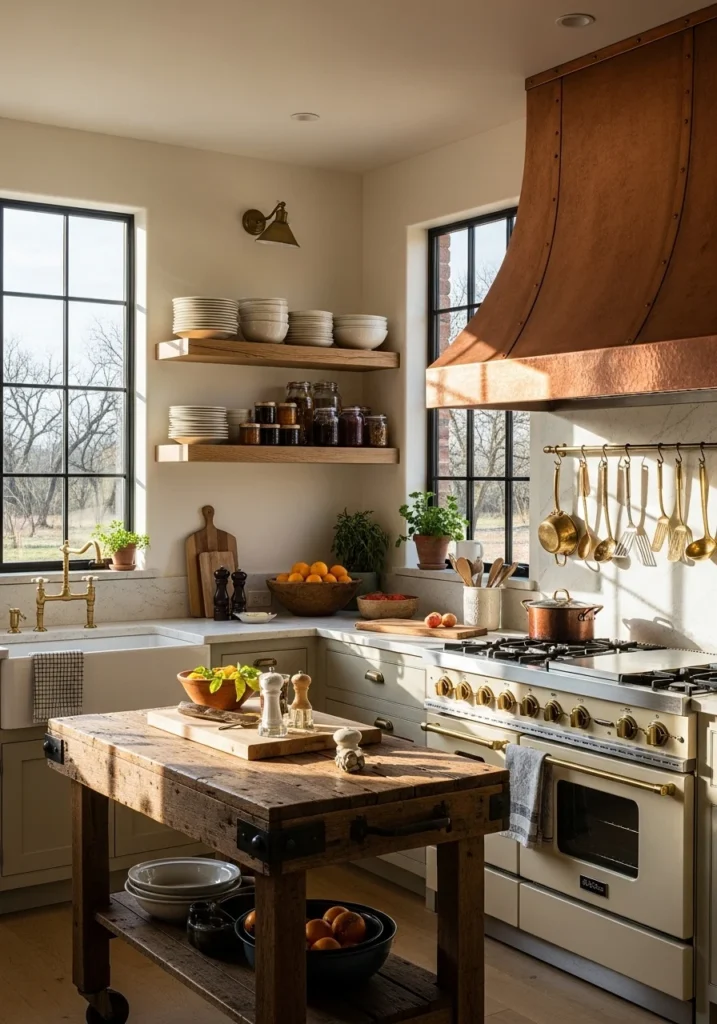
Install hammered copper range hoods over cream enamel ranges for rich metallic warmth. Pair with soapstone countertops, open oak shelving, and blackened steel window framing for material contrast.
Include reclaimed wood prep tables on casters and display vintage brass utensils. Style with stacked plates, preserve jars, and fresh citrus in wooden bowls to show the kitchen’s connection to food preservation and preparation.
Also Read: How to Style a Moody Bathroom That Actually Feels Luxurious (Not Like a Cave)
8. Create Service Areas With Glass Pantries and Butler Stations
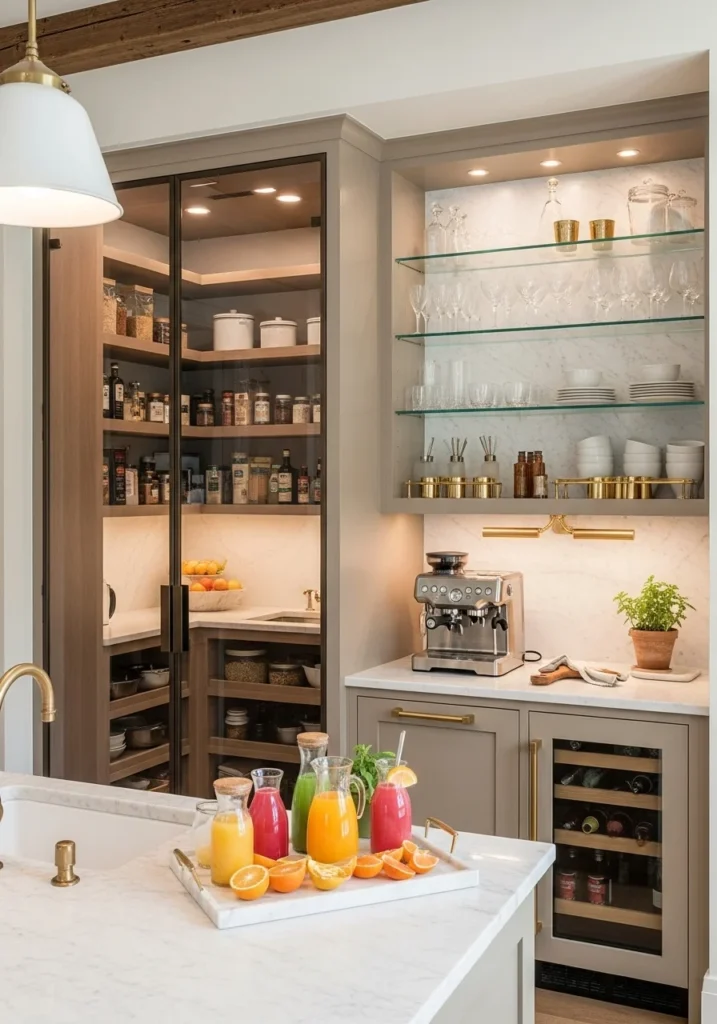
Integrate glass-front walk-in pantries with dedicated butler stations featuring marble counters. Use warm taupe shaker-style cabinetry, shallow farmhouse sinks, and brass barware storage.
Add inset espresso machines, hidden refrigeration, and open glass shelving for crystal and stoneware. Stage with decanters, coupe glasses, and small herb pots to show sophisticated entertaining capabilities.
9. Ground Everything With Black Slate and Warm Oak Contrasts
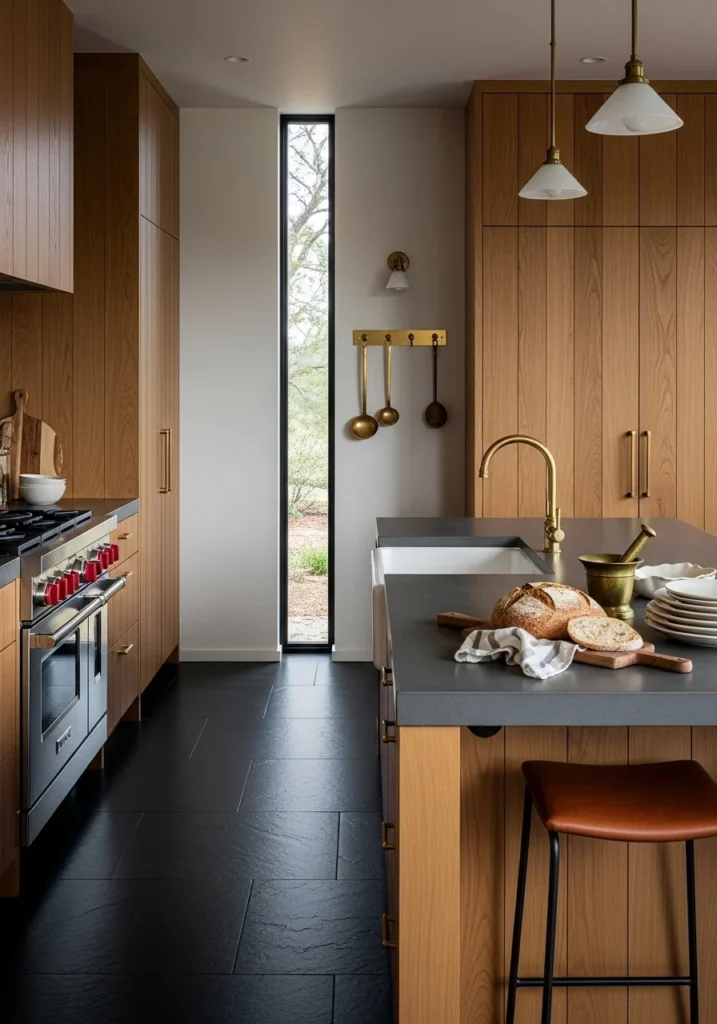
Use large black slate flooring to contrast with warm vertical oak cabinetry. Create oversized islands with matte concrete tops and integrated prep sinks, paired with cognac leather stools.
Include narrow vertical window strips for natural light and brass wall hooks for utensil storage. Stage with artisan bread, brass mortar and pestles, and stacked ceramic plates to emphasize the contrast between dark and warm materials.
10. Add Character Through Vintage Storage Solutions
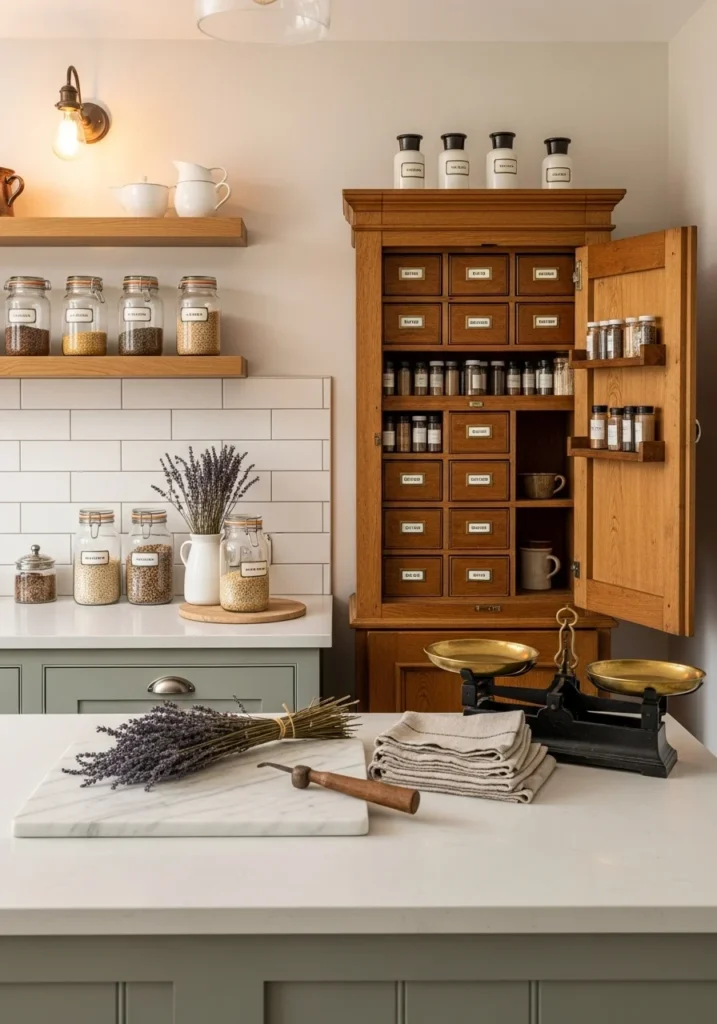
Repurpose antique apothecary cabinets as pantry storage and spice displays. Pair with white subway tile splashes, soft sage shaker islands, and oak open shelving with labeled storage jars.
Add marble pastry boards and brass scales for both function and styling. Display grain jars, dried lavender bunches, and deliberately folded linen napkins to show how vintage elements can be both beautiful and practical.
11. Balance Industrial and Rustic Elements
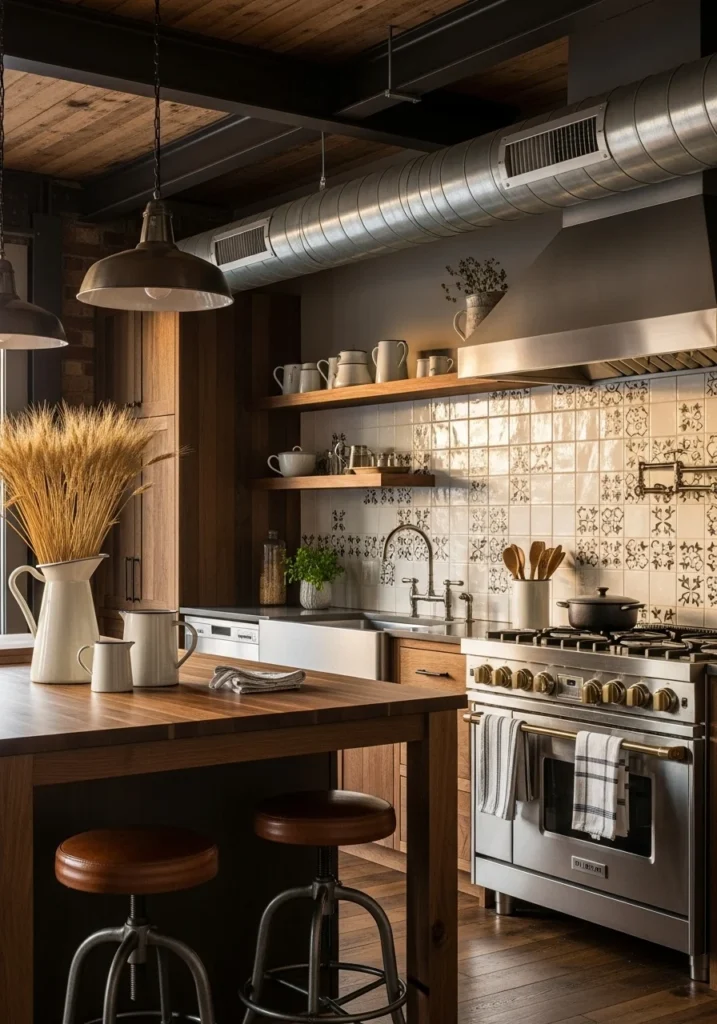
Blend exposed ductwork and steel beams with warm reclaimed wood for sophisticated contrast. Use central islands with thick walnut tops, vintage industrial leather stools, and patterned ceramic tile backsplashes.
Include stainless-steel farmhouse sinks and professional gas ranges with brass trim. Stage with wheat stalks in tall pitchers, enamel pitchers, and hand towels to soften the industrial elements with organic touches.
12. Incorporate Sustainable and Living Elements
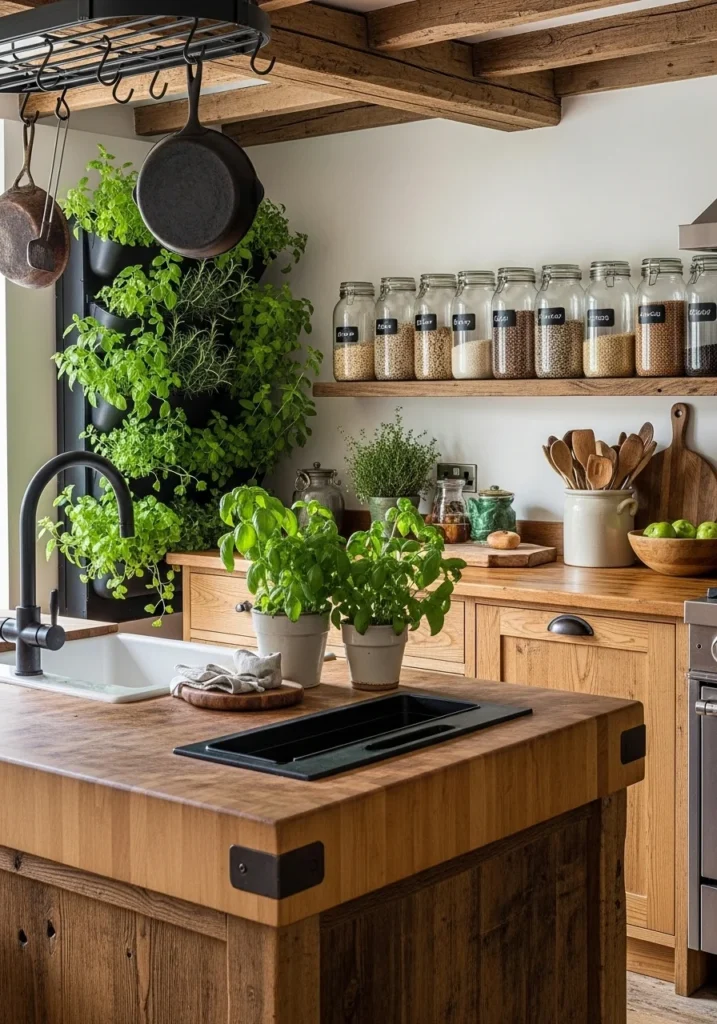
Use reclaimed pine cabinetry with living vertical herb walls near cooking zones for sustainable design. Include butcher-block islands with integrated compost bins, matte black faucets, and reclaimed beam accents.
Add glass canisters with labeled grains and hanging cast-iron skillets. Style with fresh herbs, wooden utensils in ceramic crocks, and visible growing elements that connect the kitchen to food production.
13. Create Drama Through Material Contrast
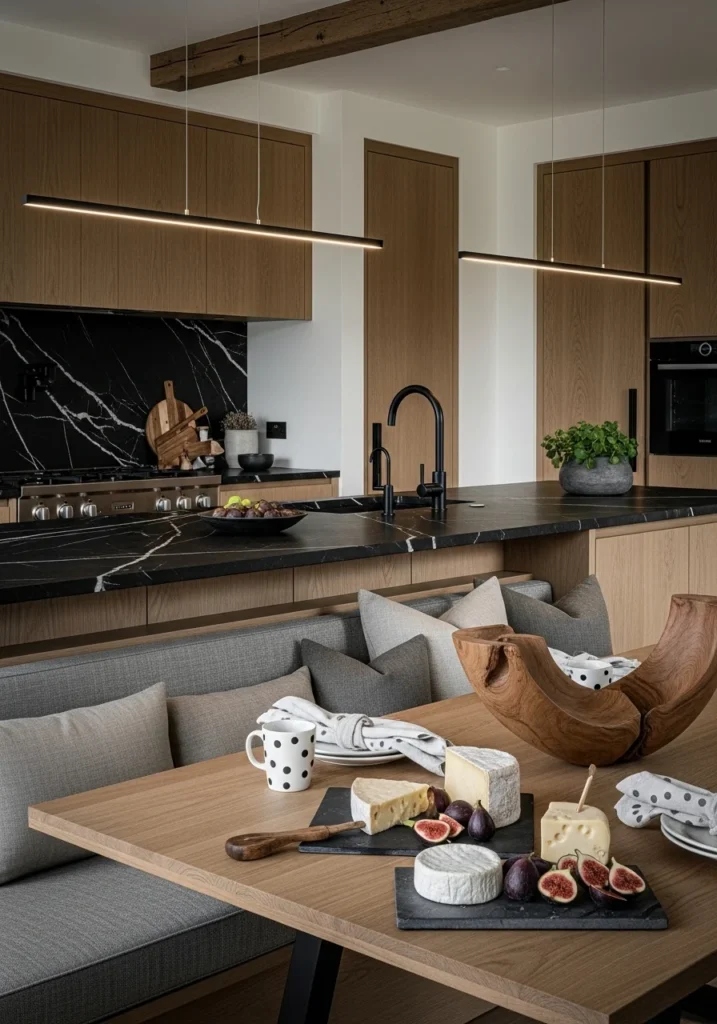
Pair dramatic black marble counters with warm veneered oak cupboards for sophisticated contrast. Use waterfall islands, black matte fixtures, and slim brass pendant lights for refined details.
Include built-in banquettes with neutral cushions and sculptural wooden centerpieces. Stage with artisan cheeses on slate boards, fresh figs, and folded linen napkins to show how dramatic materials can still feel welcoming.
14. Display Collections Through Open Shelving Galleries
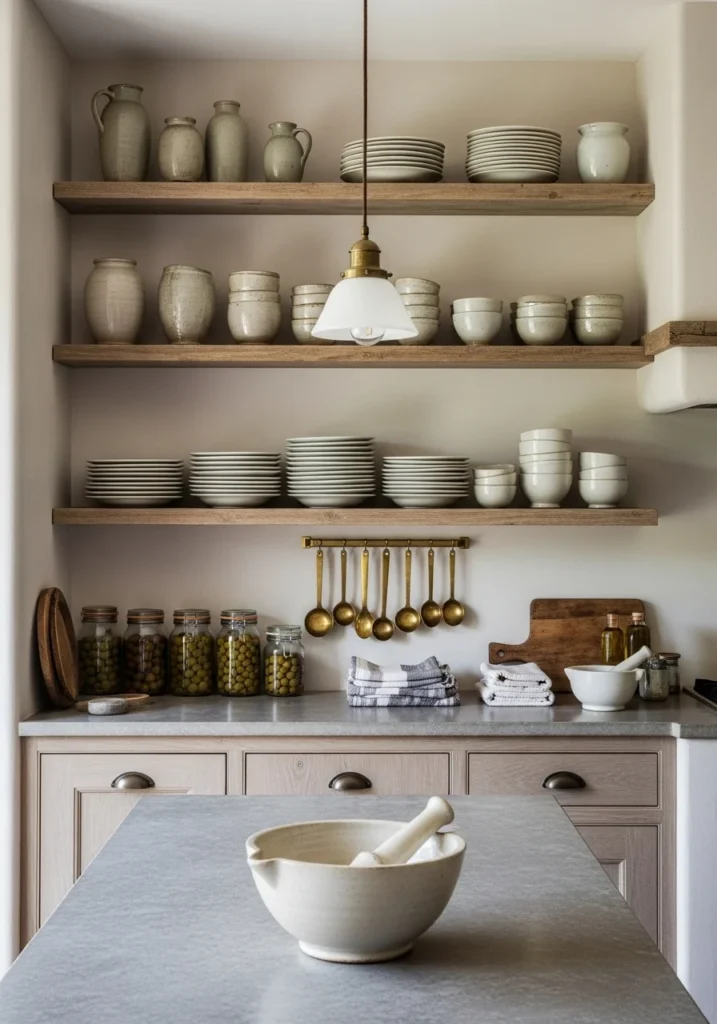
Celebrate open shelving as curated galleries using raw timber shelves against soft plaster walls. Vary shelf heights to display hand-thrown pottery, neat plate stacks, and suspended brass measuring spoons.
Add long narrow islands with stone tops and single pendant lights. Style with glass olive jars, folded muslin towels, and ceramic mortars with pestles to show how functional items can become beautiful displays.
15. Create Casual Dining With Reclaimed Timber Breakfast Bars
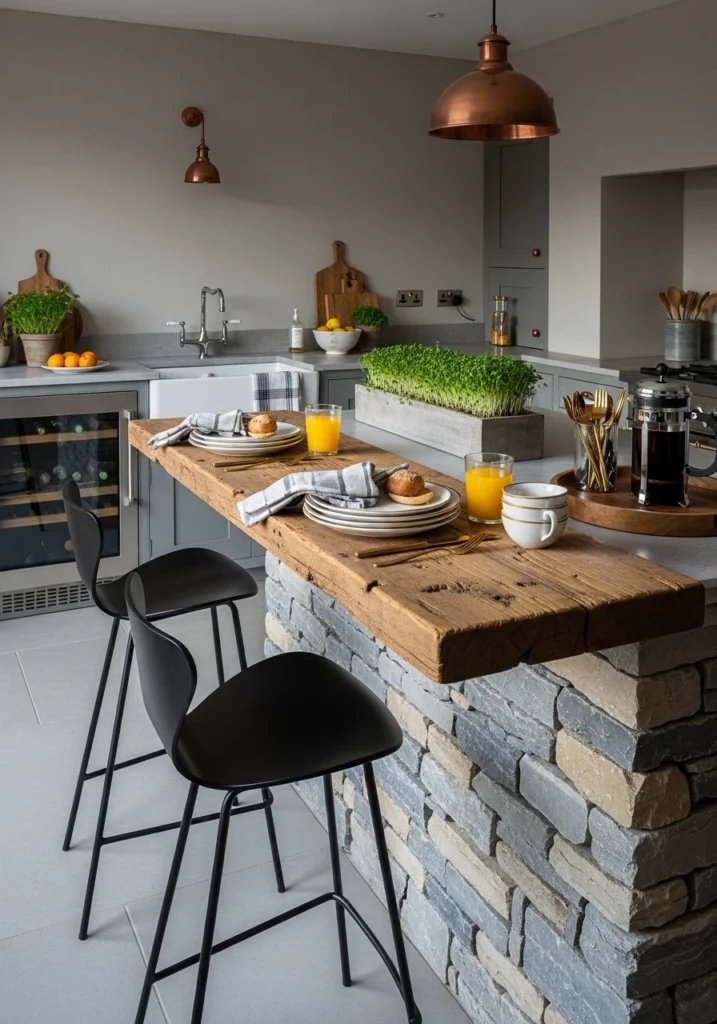
Build reclaimed-timber breakfast bars that cantilever from stone islands, creating casual dining ledges for everyday meals. Use sculptural bar stools in black steel and leather with matte plaster walls and copper pendants overhead.
Include deep basin sinks, integrated undercounter refrigeration, and narrow planters with microgreens for fresh garnishes. Stage with stacked brunch plates, brass cutlery, and French presses on wooden trays to show how the space works for casual family dining and morning coffee rituals.
Making Rustic Feel Sophisticated
The key to sophisticated rustic kitchens is restraint and quality. Don’t try to include every rustic element in one space—choose a few key materials and do them really well rather than overwhelming the space with too many competing textures.
Invest in genuine materials rather than artificial versions. Real reclaimed wood, actual stone, and quality metals will always look better than manufactured alternatives trying to replicate the authentic versions.
Balancing Function With Aesthetics
Remember that kitchens need to work for daily cooking, not just look beautiful in photos. Make sure your rustic elements don’t interfere with functionality—beautiful open shelving is great, but you still need adequate closed storage for everyday items.
Consider maintenance when choosing materials. Natural materials like wood and stone require some upkeep, so factor that reality into your decisions about what elements to include and where to place them.
Final Thoughts
Creating a rustic kitchen that feels sophisticated rather than themed requires understanding that rustic style is about celebrating honest materials and traditional craftsmanship in contemporary ways. The best rustic kitchens feel both grounded in tradition and completely current in their functionality and refinement.
When your kitchen starts feeling like a place where you genuinely want to cook and gather with people—somewhere that honors both beautiful materials and practical needs—you’ll know you’ve successfully created authentic rustic style that works for real life.

